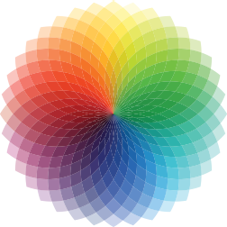224
A Closer Look at Colors
While you may know the colors of the rainbow—red, orange, yellow, green, blue, indigo, and violet—you may not have considered how the colors are related. The following color wheel illustrates this relationship.

- Primary colors are red, yellow, and blue (in paint or other pigment). They are not a combination of other colors. (In light, the primary colors are red, green, and blue.)
- Secondary colors are orange, green, and violet. They are a combination of the two primary colors next to them on the color wheel.
- Tertiary colors are the many shades of brown and tan, a combination of three or more colors on the wheel. For that reason, realistic skin tones are difficult to produce on an artist’s palette.
- Complementary colors, such as red and green or blue and orange, appear opposite each other on the color wheel. The complementary color of a primary color is the combination of the other two primary colors. When complementary colors are next to each other, they create energy and intensity.
- Related colors, such as red and violet or orange and yellow, appear close to each other on the color wheel. They tend to blend with each other, creating a sense of harmony.
- Hot colors are red, orange, yellow, and any shades closely connected with them. They are bright, eye-catching colors that create energy.
- Cool colors are green, blue, and violet. They are soothing and calming.
Your Turn Imagine that you have been given the assignment of choosing colors for the walls and furniture in the following locations. Choose three or four colors you would use in each setting and explain why:
- a doctor’s waiting room
- a rock band’s rehearsal space
- the dining room in a fast-food restaurant

